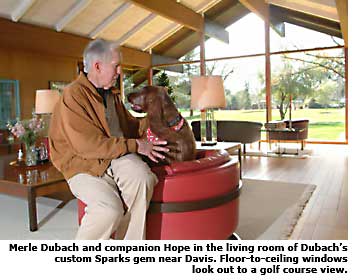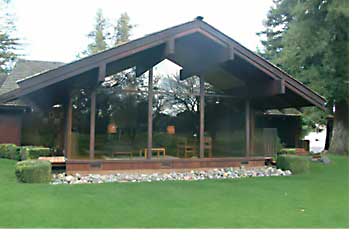Custom Carter Sparks
Merle Dubach has always taken his homes seriously. When he moved his family to El Macero, a new golf course neighborhood at the edge of Davis, it was into a house of his own design. The modern, rambling structure was inspired by the work of Clifford May, who pioneered the modern California ranch home. "I got some of it right," Dubach says, "some of the feeling of the Clifford May house."

But Dubach, a highway contractor and orange and artichoke grower, knew it wasn't his dream home. He knew it because he could see his dream home going up just a few blocks away. Dubach watched as contractors installed immense wooden beams from one end of the home to the other. He watched as its gables were hammered into place, with rafter ends dropping almost to the ground. He fell in love.
In 1979, two years after the house was built, Dubach's love was consummated. The home had been built essentially as a spec home. The family that had commissioned it was planning to move into another, large house by the same architect also being built on the American River, past Sacramento. A friend in the real estate industry called Dubach, who was on a road job in Colorado. Dubach gave him a check and told him to buy it.
The Dubach home was designed by Carter Sparks (1923-1997), one of the Sacramento area's leading residential modern architects from the 1950s on. Sparks is best known as the designer for Streng Brothers tract homes, which featured flat roofs or low gables, atriums, open plans, and walls of glass.
Although the Strengs customized many of their Sparks-designed homes for customers, says Streng founding partner Bill Streng, all were based on Sparks' standard plans for the company—and none came close to the grander homes he designed for his custom clients. Those homes, Streng says, show what Sparks could do "when he wasn't building for cheapskates." A visit to this much larger, custom home reveals much about Sparks' design sense, and much about modern architecture Bay Area style, as seen in homes by the Strengs in the Sacramento Valley and by Joe Eichler in the Bay Area.

Sparks' architecture belongs to the Bay Tradition, which blended the formal International Style of Mies van der Rohe with the warmer, more idiosyncratic and often woodsy styles of Frank Lloyd Wright and Bernard Maybeck. The architecture can be so quiet, you barely notice it—or so dramatic, you gasp. Reserved, contemplative—yet a bit of the show-off. It can seem light as air, a glass-walled pavilion—or woodsy and shingled, a tent in the forest. Much of the attraction of the Dubach house comes from the playful way it blends opposites. The home marries the weight and the expressive woodwork of Pasadena Craftsman architects Greene and Greene to the simplicity and lightness characteristic of Eichler.
The plan of the 3,400-square-foot home is so clear, you immediately grasp it. But you can spend weeks intrigued by complex rhythms set up by piers, ceiling beams, joists, and eaves. Forgetting the garage wing, the Dubach home is a Greek cross, roughly symmetrical in plan, with the living room and dining-kitchen areas filling one axis, the bedrooms the cross-axis.
From the street, the Dubach home blends so well with its neighboring, mostly ranch-style house, it almost disappears. It's low to the ground, shaded by enveloping gables, and has a long wing for the garage. You may notice the nail holes in the vertical redwood siding. What could be less pretentious?

Step inside. You notice the doorway right away—it's in one of four all-glass alcoves that form mini-wings at each corner of the home's central mass. Here, floor-to-ceiling windows meet glass to glass without wooden or metal mullions. That's quietly dramatic. Step past a mahogany-plywood paneled wall and you're in the living room, where the drama hits.
Floor-to-ceiling windows in front and to the sides reveal a golf course and mature trees. The Dubachs never installed window coverings. The lack of privacy, Dubach says, "never bothered me." Further drama comes from the rhythmic play of beams and glass, color and texture. Heavy beams support smaller beams that in turn support the cathedral ceiling. Some beams are dark, others light. The pine ceiling is bleached, its knots visible.
Other beams run along the walls, and past the fireplace—a tour-de-force of industrial steel and Foothills fieldstone covered with lichen. The fireplace is in the center of the house and clearly serves as its emotional and structural fulcrum. The fireplace is all that separates living and dining areas. But what different moods both rooms have. The dining area is warm, close.




